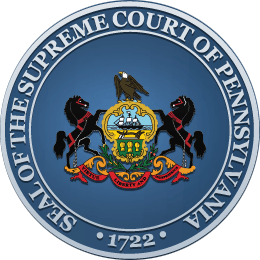History
 efore 1700, the Pennsylvania judicial system originated as a disparate
collection of local, part-time courts inherited from the reign of the Duke
of York and established by William Penn. At this time, no courts could be
called the court of final appeal; all final appeals were taken to England
for veto power. Several attempts were made to unify the colony's judicial
system and establish a court of final appeal, but failed.
efore 1700, the Pennsylvania judicial system originated as a disparate
collection of local, part-time courts inherited from the reign of the Duke
of York and established by William Penn. At this time, no courts could be
called the court of final appeal; all final appeals were taken to England
for veto power. Several attempts were made to unify the colony's judicial
system and establish a court of final appeal, but failed.
1968
The Constitution of 1968 establishes the Commonwealth Court to reduce the workload of the Supreme and Superior courts. The change alters the minor court system and reorganizes the judiciary into the Unified Judicial System, consisting of the Supreme, Superior and Commonwealth Court; Courts of Common Pleas; Philadelphia Municipal Courts; Pittsburgh Municipal Courts; Philadelphia Traffic Courts; and Magisterial District Courts, with provisions for any future courts the law might establish.
1980
The legislature approves a decrease in the Supreme Court's mandated jurisdiction by expanding that of the Superior Court. The Pennsylvania Supreme Court can now exercise discretion in accepting or rejecting most appeals. This allows the Supreme Court to devote greater attention to cases of far-reaching impact as well as its constitutional obligation to administer the entire judicial system.
Today
Even though Pennsylvania’s courts have been in existence over three centuries, it was not until 2009 and completion of the Pennsylvania Judicial Center, that the judiciary finally had a formal “home” within the “capitol complex” in Harrisburg. The Judicial Center serves as an administrative headquarters for Pennsylvania’s courts which are administered by the Supreme Court.







